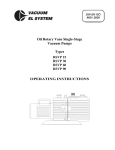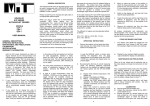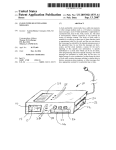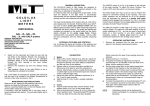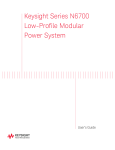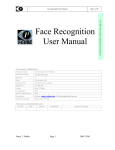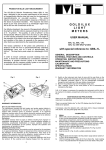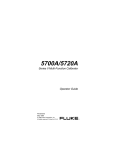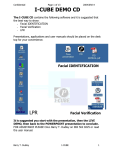Download Using a Manufacturer`s Specification as a Type B Error
Transcript
Keysight Technologies Using a Manufacturer’s Specification as a Type B Error Contribution White Paper Abstract Manufacturers’ specifications are a complicated interplay of consumer demand, contractual agreement and definition of “fitness for use” warranty. To better understand the implications of using manufacturers’ specifications in an uncertainty analysis, we will explore technical topics such as the following –– How specifications are created and managed –– Advantage of using specification –– Statistic versus managed specification –– Stationary and non-stationary random processes –– GUM concepts like “safe” –– Issue and definition of pseudo systematic error This exploration will be done using no advanced math or statistics. This paper examines these issues in the informal context of a Pachinko gambling device. As a result, it will become clear why an uncertainty analysis (employing TYPE B data) is a worst case analysis. This can affect how calibration laboratories use uncertainty data in the quality system and on customer facing documents and training. Introduction Why are manufacturers’ specifications allowed in uncertainty calculation regimens such as those discussed in GUM and E4/02? The answer is simply, “convenience.” A full ANOVA would require very specific knowledge about modern standards. Much of this paper is dedicated to the types of error contributions that are encapsulated in manufacturers’ specifications. These ideas are presented in a way that makes very complicated subjects easier to communicate. Robert L Brown, Keysight Technologies Presented at 2006 NCSL International Workshop and Symposium 03 | Keysight | Using a Manufacturer’s Specification as a Type B Error Contribution - White Paper Nature of a Manufacturers’ Specification It is important to be aware of the conflict between manufacturers’ needs and those of a metrologist seeking a statistic. Manufacturers’ needs The manufacturer needs to communicate the definition of “fitness for use.” Customers’ (end user) needs The customer wants to depend upon the manufacturer’s specification. The customer needs to know (User Manual) how to get the promised performance and what obligations that he has (environment, calibration interval, etc.). The customer wants to be able to substitute a “stock” instrument in his system with confidence that it will perform as well as the one replaced. The customer often wants a maintenance contract. Product specifications provide the required “meeting of the minds” to indicate those repairs that are (or are not) covered by that maintenance contract. Metrologists’ uncertainty needs When using specifications as Type B contributors, metrologists’ needs are the same as the end user. However, if an application uses characterized data to obtain better performance than published specifications, then that application is not supported by the manufacturer (and is beyond the scope of this paper). However, some of the concepts in this paper are useful for those characterized applications. Managed specifications The specification is therefore a promise. Manufacturers do collect statistics as they design for manufacturing. However, in the end, the manufacturer must decide what he can promise to deliver for a period of many years. Later in this document we will discuss the incredibly large margins required to make that promise cost effective. GUM[1] Sections E.2.1 and E.2.2 make a case for a realistic uncertainty with a confidence interval. However, the use of specifications in an uncertainty analysis will in most cases make the analysis conservative (and in conflict with E.2). It is impossible to predict, at the time the specification is defined, when and for which (future) serial numbers the specification will be realistic. The flexibility that is afforded to manufacturing (due to process margins Cpk and Cp) actually makes the price of many modern standards (especially multi-parameter) much less expensive. Robust engineering designs allow manufacturing to make the promise, and manage to the specification. 04 | Keysight | Using a Manufacturer’s Specification as a Type B Error Contribution - White Paper Pachinko Machine Error Contribution Types To identify the major types of error contributions, we will examine a device designed to create randomness: the Pachinko gambling machine. We will identify types by how they need to be handled rather than by source or root cause. This discussion will emphasize the difficult issue of “time.” Pachinko machine metrics For our analysis purposes (Figure 1A) the machine will be outfitted with a coordinate system. The horizontal scale is in units of peg spacing. Note that zero indicates the initial position of every ball that is dropped into the array of pegs. The vertical scale is in units of months, Jan = 1, Feb = 2, etc. Combined uncertainty When describing randomness, we will consider one sigma numbers in this example. The question to answer is, “What is the combined uncertainty of the machine?” A Pachinko machine (Figure 1A) features a binning mechanism that creates a histogram of Pachinko balls. You can see by inspection that the standard deviation is approximately 3.9 units. A Figure 1. B 05 | Keysight | Using a Manufacturer’s Specification as a Type B Error Contribution - White Paper Pachinko Machine Error Contribution Types (Continued) Potential variation shapes Uncertainty in the actual path of a ball is represented graphically by a dark shaded shape. The top of the shape indicates the assumed entry point. The width of the base of the shape indicates the standard uncertainty of the exit. The names given (Figure 1B) to these shapes were chosen to make the analogy to a calibration standard more convenient later in this paper. The line down the center indicates the expected (most likely) path of the ball. When the analogy is complete, and an infinitely dense lattice of pegs is assumed, this expected path is a straight line. Calibration shape The top (Figure 1B) shape (isosceles triangle) indicates that a ball that enters at the top (they all do) will be distributed at the bottom by a standard uncertainty indicated by the width of the base. The base was calculated by making a table of the space into which the first 100 balls fell. (The two most likely spaces got the value 0.5, the next 1.5, etc). Then the standard deviation of those 100 observations was calculated to be 2.32 units. The width of the base reflects this value. For the purpose of analogy, the vertical distance is not interesting in units of time. The shape only indicates the input and the output of the calibration process. Drift shape The middle (Figure 1B) shape (dome) indicates the randomness in a ball’s path caused by the pegs. The base width was calculated in a similar way to the calibration uncertainty. The 100 data points indicated where a ball exited the maze relative to the space that it entered. Then the standard deviation of those 100 observations was calculated to be 2.91 units. The width of the base reflects this value. In this shape, the vertical distance is significant and measured in units of months. The dome shape is also significant. We know that the ball is equally likely to move left or right at each peg. If the ball never moved more than one space left or right then the result of this path is the binomial distribution and the variance of the drift shape would be np(1-p) = n/4. However, it is clear from watching the simulation that horizontal motion of multiple spaces is common. As long as the expected (average) horizontal motion is constant, the variance will increase linearly with n. Since we are indicating the standard deviation, the dome shape width indicates that standard deviation at each height. Sigma = SQRT(2.415 * t) where t is in months Equation 1 06 | Keysight | Using a Manufacturer’s Specification as a Type B Error Contribution - White Paper Pachinko Machine Error Contribution Types (Continued) Reproducibility shape The lower (Figure 1B) shape (isosceles triangle) indicates the randomness in a ball’s path exiting the pegs at an other than vertical angle. Note that there is additional uncertainty caused by the histogram binning. As in the previous cases, a table of 100 values was constructed by noticing which bin captured the ball. The value is the horizontal displacement of the bin relative to the space where the ball exited the lattice. The width of the base reflects the standard deviation of the 100 observations. The vertical distance is not significant in units of time. Total combined standard uncertainty bar The shaded bar at the bottom indicates the combined effect of the three potential variation shapes discussed above. The width of this bar is simply the RSS (root sum of squares) combination of the three standard uncertainties, approximately 3.9 units as expected. Using potential variation shapes What if we repeatedly drop balls into the middle of the lattice? Can we use what we have learned to predict the result? Figure 2. What if we drop balls into the lattice at the X (Figure 2) on March 15. What will be the combined standard uncertainty of the total result? –– There will be no calibration contributor –– The drift contribution will be 1 month’s worth; (Equation 1) UD = SQRT(2.415 * 1) = 1.55 –– The repeatability will be as in 3.3.3, UR = 1.1 Total sigma = SQRT(UD2 + UR2) = 1.9 units The mean = –5 units 07 | Keysight | Using a Manufacturer’s Specification as a Type B Error Contribution - White Paper Calibration Standard (Pachinko Analogy) Unlike a Pachinko machine, a calibration standard is designed to minimize randomness. The purpose of a calibration standard is to preserve a parameter. It needs to transport a parameter value from one place to another and from one time to another. We will use the obvious Pachinko randomness to help model the difficult to manage, tight tolerances of a calibration standard. Simple model Assumptions: –– Calibration, drift and reproducibility contributors are independent –– No (left/right) bias in the random walk (peg symmetry horizontally) –– The drift/time random walk is relatively constant (uniform peg spacing) As a result of these assumptions, the expected value of population is zero error. If these same assumptions are appropriate for a calibration standard that you use or manufacture, then the Pachinko model will apply to that standard also. Expected value = Mean = 0 Combined standard uncertainty = SQRT(UC2 + UD2 +UR2) where UD = SQRT(k * t), t = cal interval and k = (variance at t = 1) A Figure 3. B 08 | Keysight | Using a Manufacturer’s Specification as a Type B Error Contribution - White Paper Calibration Standard (Pachinko Analogy) (Continued) To help adapt to the calibration standard, we will allow only a small number of balls. Each ball will be stenciled with a year, beginning with year 2000 and ending this year. (Figure 3B) This models a calibration standard that was purchased and calibrated Jan 1, 2000. With a calibration standard we get to drop only one single ball each year on Jan 1 (beginning of the one year calibration cycle). Figure 4. Pseudo systematic error Customers who use this standard earlier in the year will experience less pseudo systematic error than near the end of the calibration cycle (Figure 4). In this model, the actual value of the standard was low by seven units on July 15, 2000 but, four units high on July 15, 2001. The user has no way of knowing the actual error. The user will believe that the standard is still accurate with a visible random variation, equal to the reproducibility contribution. The pseudo systematic error appears to be trapped in time and is sometimes referred to as a “time trap”. For novice metrologists, pseudo systematic errors are easier to grasp than the concept of random variables in the frequency domain. In the absence of delta environment systematic errors, total pseudo systematic error can be measured, with an uncertainty of the calibration contribution. This is the motivation for time series analysis of the “incoming” data from the calibration reports. Keep in mind, that the calibration contribution includes a component similar to the reproducibility component and time traps of its own. If the traceability path is very long, you could easily be getting a value from the Standards Lab that was sampled at the National Laboratory many years ago. 09 | Keysight | Using a Manufacturer’s Specification as a Type B Error Contribution - White Paper Calibration Standard (Pachinko Analogy) (Continued) Full model (inclusion of systematic error) In practice, the design of a calibration standard must include systematic errors. Systematic errors are those errors that cause the expected (or mean) error to be nonzero. Those errors are of three types. A B Figure 5. Asymmetric drift bias (Figure 5A) This is analogous to pegs that are slightly off center. This bias is related to the size of the drift uncertainty (look up binomial distribution). Since there is no way to distinguish this linear drift (due to asymmetric drift bias) from non-random drift, it is recommended that asymmetric random drift never be assumed. Non-random drift (Figure 5B) Non-random drift without an associated random drift is analogous to binding the pegs into chutes, using wire. This can be considered to be the regression function (as in linear regression) when separating the random drift (residuals) from the non-random drift (function). Sources of non-random drift include: –– Aging of the standard –– Wear-out mechanisms –– Use –– Tension releasing from last mechanical adjustment The example in Figure 5B shows non-random drift dominating the random drift. This can happen in a standard weight. Each time it is used, a small amount of mass is removed. C 10 | Keysight | Using a Manufacturer’s Specification as a Type B Error Contribution - White Paper Calibration Standard (Pachinko Analogy) (Continued) Offset (Figure 5C) This type of systematic error, represented in Figure 5C, cannot be realized with pegs and balls as depicted. However, the figure does better communicate the nature of the offset error in a calibration standard. In a balls and pegs machine, it would be an offset in the top and bottom scales in the diagram. The illustration in Figure 5C was chosen to emphasize that offset should be considered the non-random calibration error contributor. This reminds us that the most difficult and often undiagnosed offset errors are “delta environment” errors. Sources of delta environment errors include: –– Equipment used at a different temperature, humidity, or altitude than when calibrated –– Uncorrected offsets when used that were corrected when calibrated –– Procedure for using the standard is very different than the calibration procedure used –– The full model will include a constant term that represents the offset error. Full model error equation Summarizing what has been said above, Error( t ) = EO + E * t + C + D + R Equation 2 EO = Delta environment and uncorrected offsets (often assumed = 0) E = Systematic drift of the standard (often assumed = 0) C = Calibration random variable with expectation = 0, sigma = UC D = Drift random variable with expectation = 0, sigma = UD = SQRT(k * t) R = Reproducibility random variable with expectation = 0, sigma = UR If we could know (which we cannot) the value of each term at the precise instant, t, that a standard is used, then we would have the exact error and know the “true” value spoken about in GUM. 11 | Keysight | Using a Manufacturer’s Specification as a Type B Error Contribution - White Paper Using a Calibration Standard When a calibration laboratory uses GUM to estimate the uncertainties of the calibration procedures, it is required to: 1. Identify the significant systematic errors 2. Correct the significant systematic errors 3. Add an error contribution for each of the correction factors Random errors are to be expected values, not “safe” or worst case. Systematic errors To the extent that some systematic errors are “hidden” in the manufacturer’s specification, this requirement cannot always be met. For example, there is usually a temperature requirement in the user manual, but no indication of the amount or direction of the error when using the calibration standard near the edge of the requirement. Random errors In practice, no one recommends that the expected value of the drift component be used, even if it is the dominant contributor. If the expected value were used, then the variance, UD(t)2, would be multiplied by the probability distribution of calibration events, P(t), and integrated over the standard’s calibration interval to obtain the expected drift variance (the expected value of the variance is an unbiased estimator). If (as is most common) the standard is used uniformly throughout the year, then the corrected UD is given by UD/SQRT(2). In fact, no one objects to using the worst case UD and many would likely object to this reduction in favor of the worst case number. 12 | Keysight | Using a Manufacturer’s Specification as a Type B Error Contribution - White Paper Multi-Function Electronic Standards Multiple parameters can effect the uncertainty budget in subtle ways. Accumulated effect of many uncorrelated parameters To illustrate the problem of multiple sources for error, let us consider a multi-function voltmeter. Assume that the specification for each functional parameter is 95% confidence. Remember that only one parameter needs to fail to get an out of tolerance for the entire box. If each of the 100 parameters was uncorrelated with the others, then the expected number of failures per calibration would be five. This will not do. All functioning boxes will fail “incoming” data when in for calibration. It is easy to see that for confidence of 95%, each of the 100 independent parameters would require: Parameter confidence = 0.95(1/100) = 0.95 0.01 = 0.99949. This problem is mitigated in the design by making the parameters correlated. A good example is a self-calibrating multimeter or calibrator that depends primarily on the accuracy of only two high precision (internal) standards and an extremely linear A/D converter. This multi-function dynamic is one of the reasons that the true performance is typically much better than the product specification. A single parameter may have a budget tighter than the parameter’s published specification. Highly correlated parameters To illustrate the problem of correlated sources for error, let us consider the flatness of a radio frequency standard. Suppose that adjustment of the highest frequency gain is correlated with the lowest frequency in that band. If the calibration procedure can only minimize the difference (but never achieve zero), then the adjustment of absolute gain may (by design) require one parameter to be high and the other low. This offset, in effect, removes that difference from the available specification budget. 13 | Keysight | Using a Manufacturer’s Specification as a Type B Error Contribution - White Paper Single Parameter Calibration Standard In this section we will be explore the second reason that true performance is typically much better than the product specification. That reason is, “the unknown.” The manufacturer has a similar problem to that of a calibration procedure. Both have an uncertainty budget and a finite number of contributors. A product with cuttingedge specifications (like a metrology standard) has a large number of known error contributors. But there are also a large number of potential error contributors that may be unknown. Accommodation of the unknown contributor in a robust manufacturing process is accomplished by margin. Design changes Not all design changes are intentional. Any supplier of parts can change the design. Also, deliberate changes in the design to improve the product, can uncover a previously unimportant error contributor. Consider again the Pachinko machine. Look closely at the top row of pegs. A Figure 6. B C D E 14 | Keysight | Using a Manufacturer’s Specification as a Type B Error Contribution - White Paper Single Parameter Calibration Standard (Continued) Parts change – square pegs The supplier of pegs begins shipping pegs with flat contact surfaces. There is now a variability in the drift distribution. Drift now depends upon the orientation of the peg when inserted by production assembly workers. –– Peg A: Original design: no bias –– Peg B: Horizontal: no bias –– Peg C: Tilt: right bounce bias –– Peg D: Edge: no bias –– Peg E: Tilt: left bounce bias There is an increase in the drift variability, but the dominant contributor to drift variability is still peg spacing. Peg spacing is in good control and maintained by the accurate physical distance between holes in the back plane. The product has less margin but still meets specifications. Process change – robotics The Pachinko machine manufacturer soon finds the need to automate in order to keep up with the increasing demand. Robotics are installed to achieve faster peg placement and more consistent results. However, insufficient attention is paid to peg orientation and pegs are ALL placed as in Figure 6E. The minor variability in the drift standard uncertainty disappeared, and became slightly less than the original design sigma. However, a significant bias was also introduced in the expected value toward the left. Then gamblers (noticing that more balls fall to the left of zero) can gain an advantage over the house odds. Fortunately, this process flaw was identified as an out of control value for E (Equation 2). E = Systematic drift of the standard (often assumed = 0) The batch of first production machines for the new robot assembly line was re-worked, with careful registration of pegs as in Figure 6B. The peg supplier contract was amended, specifying round pegs for future peg orders. 15 | Keysight | Using a Manufacturer’s Specification as a Type B Error Contribution - White Paper Using the Standard The customer purchases a calibration standard because the instrument’s specifications are sufficient for the procedure(s) in which it will be used. What is the standard uncertainty contribution It has become convention to use (specification limit)/SQRT(3) as the standard uncertainty. That is a reasonable estimate of the worst case (when not stated conservatively) published specification. It is beyond the scope of this paper debate which worst case probability distribution to assume. However, we have discussed the difficulties in predicting and controlling the D term in Equation 2. If you encounter the worst case condition from a factory, it will likely be caused by uncertainty in the value of UD and ability to control UD. This can result in a relatively uniform distribution in the value of UD but certainly not the value of total error. It is the recommendation of this author to use (specification limit)/SQRT(3) as the standard uncertainty and treat the contributor as if it were Gaussian normal. If there is reason in the specification to assume otherwise (such as a resolution specification), then use that information. Monitoring a calibration standard A calibration and maintenance contract is an effective way to manage costs and guarantee the product specification of a calibration standard. There are additional risks that are the responsibility of the ETE manager and calibration system manager. –– Units get damaged –– Units age –– Units get repaired with side effects A well managed calibration standard can avoid the consequences of these types of defects. By monitoring your customers’ calibration results, using check standards and monitoring calibration histories of your standards, you can avoid a great number of potential problems. Out of tolerance reports If the standard receives an OOT report from a calibration event, the lab that owns the equipment will have a process to evaluate the impact and take appropriate action for its customers. Even though the instrument was adjusted and has a compliant calibration for “out going” data, this unit may not be operational. The lab should check the previous calibration for an OOT on the same parameter. In this case, the unit should be repaired; it does not meet the manufacturer’s specification. It is not a good policy to shorten the calibration interval. Shortening the calibration interval can mask an accelerating problem, where early detection could minimize the impact. Shipping the standard It is not a good policy to allow a standard out of the calibration laboratory. This is especially true of primary standards that are calibrated by a higher echelon laboratory. A check standard is critical when shipping for external calibration. Compare the standard to the check standard before shipping and again, immediately upon its return. 16 | Keysight | Using a Manufacturer’s Specification as a Type B Error Contribution - White Paper Using the Standard (Continued) Adjustment strategy If you are using a return to factory calibration service, then the factory recommend practice will be optimal. You can determine the adjustment strategy by monitoring the calibration report history for your standard. Adjustment for offset may require additional attention if you are claiming compliance with GUM in the uncertainty analysis. Adjust to nominal value This is the most common adjustment. This is for standards that have a value of zero for terms EO and E in Equation 2. You can identify this adjustment by no bias in the “out going” validation data report (Figure 1B). Adjust for drift This compensates for the effect of a non-zero value for E in Equation 2. You can identify this adjustment by a bias in “out going” validation report data and a bias in the opposite direction when reviewing the “incoming” data at the next calibration event (Figure 5B). The manufacturer has included the uncertainty of this correction in the published specification. Unadjusted offset Small offsets are often not accommodated by an (other than nominal) adjustment strategy. Rarely, however you may see a dominant offset that is not adjusted out. This is usually due to the adverse effect on another parameter. This has the effect of radically tightening the manufacturer’s error budget and treating this more like a one sided test limit. DUTs As a commercial standard is used to calibrate a “device under test”, you have a similar adjust policy problem. This problem is greater when there is no written adjust policy available from the manufacturer of the DUT. You can validate your own adjust policy by monitoring the DUT calibration histories for the same model. GUM compliance When using the specification as a type B contributor to the standard’s uncertainty, the unadjusted offset is not consistent with GUM. In practice this condition is usually ignored and the standard uncertainty is usually entered as (specification limit)/SQRT(3). However, if you encounter the unadjusted offset in your own DUT calibration procedure, it will require special attention (much better than 4:1 TUR) in the same way that a manufacturer attends to this case. 17 | Keysight | Using a Manufacturer’s Specification as a Type B Error Contribution - White Paper Summary Although the true performance is typically much better than the product specification, it is guaranteed that some parameters for some serial numbers will be represented accurately without margin. Most customers and all manufacturers intend for specifications to be treated as the statistic for worst case performance. The typical performance of a calibration parameter is often much better than the specification, except when it is not. The problem statement is, “When is it not?” This does not matter to owner of the standard unless the owner is depending upon “better than specification” performance. If the owner is using characterized data or extended calibration intervals, then a very thorough risk analysis is indicated. Acknowledgement The author thanks Brad Jolly of Keysight Technologies for reading the manuscript and providing many useful suggestions. References 1. Guide to the Expression of Uncertainty in measurement, International Organization for Standardization, 1993 Keysight Services Keysight Infoline www.keysight.com/find/KeysightServices Flexible service solutions to minimize downtime and reduce the lifetime cost of ownership. www.keysight.com/find/service Keysight’s insight to best in class information management. Free access to your Keysight equipment company reports and e-library. This information is subject to change without notice. © Keysight Technologies, 2012 - 2015 Published in USA, April 27, 2015 5991-1264EN www.keysight.com


















